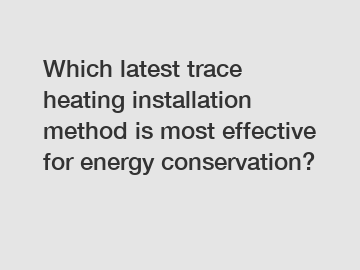Which latest trace heating installation method is most effective for energy conservation?
In our quest to build a sustainable future, energy conservation has emerged as one of the most crucial aspects. Industries and residential buildings alike have been exploring various technologies that can effectively reduce energy consumption while still ensuring optimum performance. Trace heating, an essential process in numerous industries, has witnessed significant advancements in recent years, particularly in terms of energy conservation. In this blog, we will delve into the latest trace heating installation methods and evaluate their effectiveness in conserving energy.
1. Self-regulating Heat Tracing Systems.
Self-regulating heat tracing systems have revolutionized trace heating installation methods in their energy-saving potential. These systems consist of cables with conductive polymers that become less conductive as the temperature rises. This "self-regulating" characteristic allows the heat output to adjust automatically according to the surrounding temperature conditions. Consequently, these systems consume less energy as they only generate the required amount of heat.

These heat tracing systems are highly versatile and adapt well to harsh environments. They efficiently prevent leaks, freeze-ups, and ensure optimal performance in a wide range of applications, including pipelines, storage tanks, and industrial process equipment. Their energy efficiency, coupled with the ability to adapt to varying conditions, makes self-regulating heat tracing systems an excellent choice for energy conservation.
2. Advanced Insulation Technologies.
Incorporating advanced insulation technologies during trace heating installations plays a vital role in optimizing energy conservation. Insulation materials with low thermal conductivity significantly reduce heat loss by providing a barrier between the heat trace and the external environment. Modern insulation solutions utilize foams, aerogels, and composite materials, maximizing their thermal resistance while minimizing bulk.
In addition to reducing heat loss, these advanced insulation technologies contribute to energy conservation by minimizing the heat-up time required to reach the desired temperature. By reducing the time and energy needed to warm the system, valuable resources are conserved. Furthermore, proper insulation can also extend the lifespan of the heat tracing system, reducing maintenance and replacement costs.
3. Intelligent Control Systems.
Intelligent control systems are a game-changer in energy conservation for trace heating installations. Utilizing smart thermostats and sensors, these systems actively monitor and regulate the operating conditions, optimizing energy usage. In traditional systems, heat tracing operates continuously, regardless of the actual need for heat. Intelligent control systems eliminate this inefficiency by activating the trace heating only when and where it is required.
These systems are designed with programmable features that allow easy customization to meet specific heating requirements. By integrating temperature sensors and timers, they accurately assess the temperature changes in real-time and adjust heat output accordingly. Through continuous monitoring and adjustments, intelligent control systems ensure energy is utilized optimally, resulting in substantial energy savings.
4. Heat Recovery Systems.
Heat recovery systems are gaining prominence as highly effective installations to conserve energy in trace heating processes. These systems utilize waste heat from various industrial processes, transferring it to areas where additional heat is required. Instead of generating heat from primary energy sources, heat recovery systems repurpose unused heat, resulting in significant energy savings.
By reducing energy consumption, heat recovery systems offer a practical solution for sustainable trace heating. These installations can be particularly advantageous in industrial sectors with high heat generation, such as manufacturing plants or power plants. Implementing heat recovery systems not only conserves energy but also reduces greenhouse gas emissions, promoting a greener and more eco-friendly environment.
Conclusion.
In the pursuit of energy conservation, the latest trace heating installation methods have brought forth exceptional advancements. Self-regulating heat tracing systems, advanced insulation technologies, intelligent control systems, and heat recovery systems collectively strive to maximize energy efficiency while maintaining optimal performance.
Whether it's the adaptability of self-regulating heat tracing, the insulation materials minimizing heat loss, the intelligence of control systems, or the practicality of heat recovery, each method plays a significant role in conserving energy. By incorporating these cutting-edge techniques, industries and residential buildings can mitigate their environmental impact while simultaneously reducing energy consumption and costs.
As we continue to embrace a more sustainable future, it is imperative to prioritize energy conservation at every step. By adopting the most effective trace heating installation methods, we pave the way for a brighter and greener tomorrow.
If you want to learn more, please visit our website N2 Leak Test, Retro Jetting China, Flange Management Services.
272
0
0


Comments
All Comments (0)